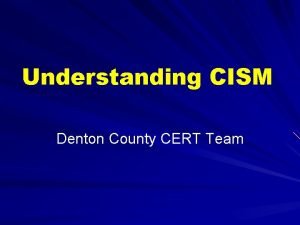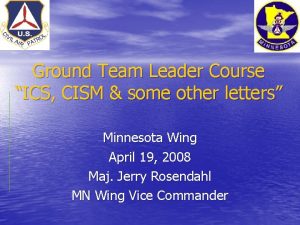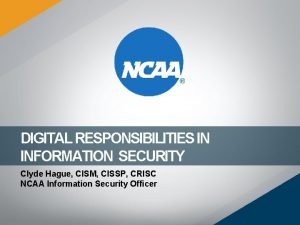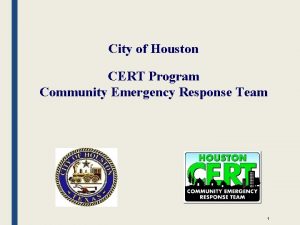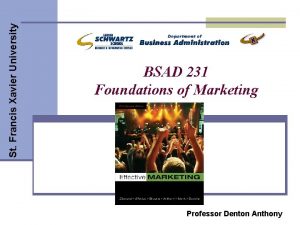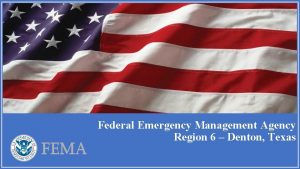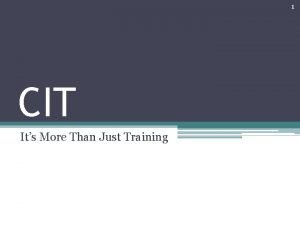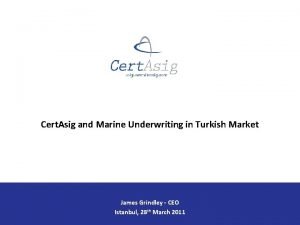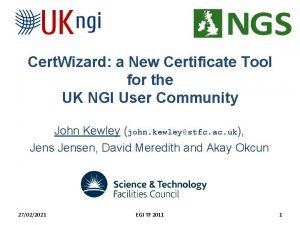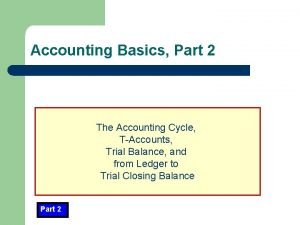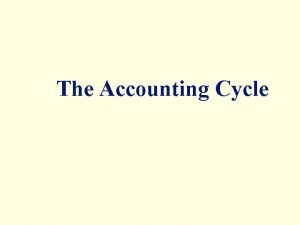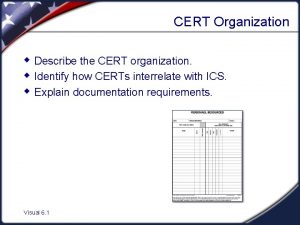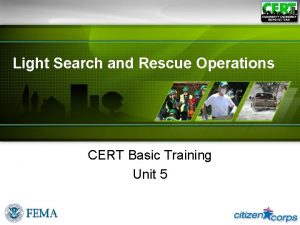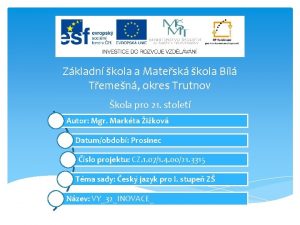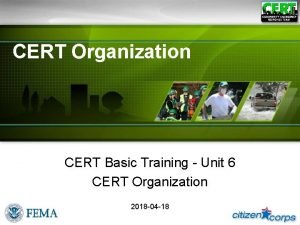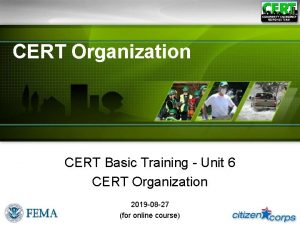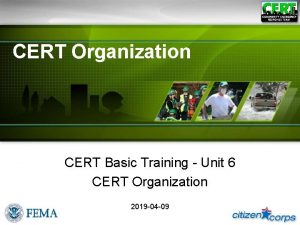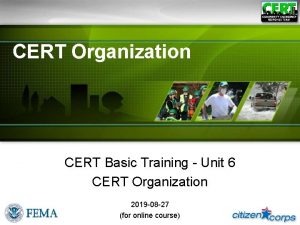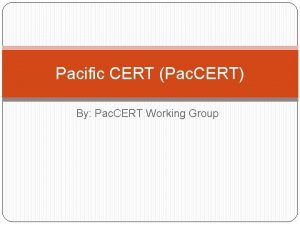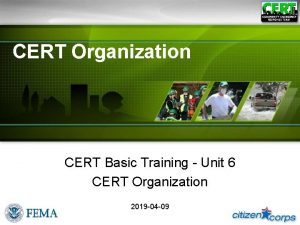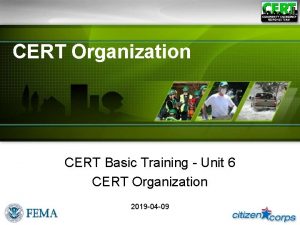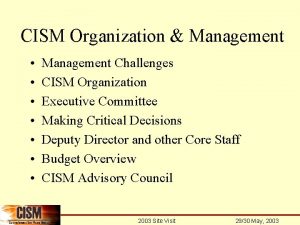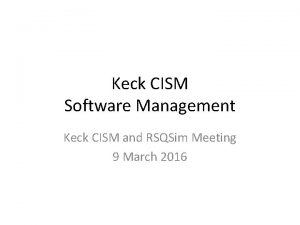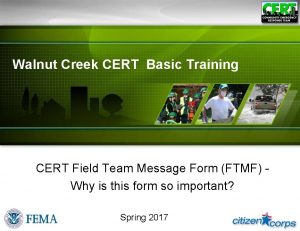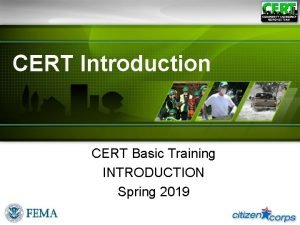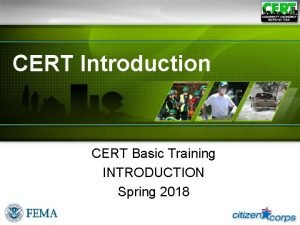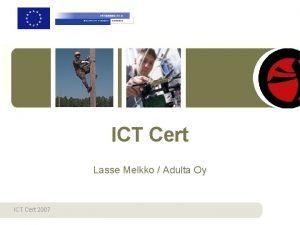Understanding CISM Denton County CERT Team What is





































- Slides: 37

Understanding CISM Denton County CERT Team

What is CISM ? Critical Incident Stress Management

RESPONSE to a stimulus characterized by increased psychological AROUSAL

In SIMPLE terms Stress Is: NORMAL reaction by a NORMAL person to a ABNORMAL situation.

Two Types of Stress EUSTRESS = Positive, motivating stress (increases performance) DISTRESS = Excessive, debilitating stress (decreases performance)

Physiological Aspects of Stress

Responses To Stress Hormonal dump into the bloodstream Increased heart rate & respiration Increased blood flow to larger muscles Tension of large muscles

Reasons For These Reactions FIGHT ! FLIGHT !

Common Symptoms of Stress (US Army Study, 1944) Nausea Feeling faint Cold sweats Loss of bowel control

Psychological Aspects of Stress

Ingredients For Distress In order for an event to become stressful, it must be interpreted or appraised as being: CHALLENGING, THREATENING, or ADVERSE, and MEANINGFUL.

Critical Incident Stress (CIS) AKA: Post Traumatic Stress (PTS) NORMAL reaction by a NORMAL person to a ABNORMAL situation.

Signs and Symptoms of Distress I. III. IV. V. Cognitive (Thinking) Emotional Behavioral Physical Spiritual

I. COGNITIVE (Thinking) DISTRESS Sensory distortion Confusion (“dumbing down”) Inability to concentrate Difficulty in decision making Guilt Preoccupation (obsessions) with event Inability to understand consequences of behavior Suicidal/homicidal thoughts Psychosis

II. EMOTIONAL DISTRESS Anxiety Irritability ANGER ! Panic (often associated with self medication) Vegetative Depression Fear, Phobia, Phobic Avoidance Post-Traumatic Stress (PTS) Grief (Mourning associated with loss)

III. BEHAVIORAL DISTRESS Impulsiveness Risk - taking Excessive Eating Alcohol/Drug Use Hyper-startle Violence Sleep Disturbance Withdrawal Family Withdrawal Crying Spells 1000 - yard Stare Antisocial Behavior

IV. PHYSICAL DISTRESS Tachycardia, Bradycardia Headaches Hyperventilation Muscle Spasms Psychogenic Sweating

IV. PHYSICAL DISTRESS (Con’t. ) Fatigue/ Exhaustion Indigestion, Nausea, Vomiting Blood in stool, sputum, vomit, urine Chest pain Loss of Consciousness

V. SPIRITUAL DISTRESS Anger at God Withdrawal from Faith-based Community Loss of moral compass

What is Crisis Intervention ? First Aid for emotional distress caused by a traumatic experience: Allowing people to “vent” (explain) their thoughts about the incident Helping people understand they are “OK” Teaching them good coping skills Assessing if additional care is needed

Crisis Intervention Characterized by: PROXIMITY – close to incident IMMEDIACY – early intervention (“trauma membrane”) EXPECTANCY – belief this can help SIMPLICITY – simple, concrete strategies BREVITY – interventions short, not longterm care PRACTICALITY – easy to implement

Crisis Intervention Goals: STABILIZATION of symptoms (keep things from getting worse) REDUCTION of symptoms (stress relief) RESTORATION of independent function (“back on the street”) ACCESS to additional care (if needed) (adapted from Caplan, 1964, Preventive Psychiatry)

Crisis Intervention What crisis intervention is NOT: NOT NOT Counseling Psychotherapy Substitute for Counseling or Psychotherapy

Types of Stress Cumulative Stress Unresolved everyday stressors (“Burnout”) Critical Incident Stress Result of a single, traumatic event Which is most likely to cause greatest harm? Cumulative – silent & slow

TWO TYPES OF STRESS Cumulative Stress “Critical Incident” (“Burnout”) (Traumatic) slow erosion of functioning incomplete work lateness impulsive need for change chronic physical illness normal coping overwhelmed adaptive functioning interrupted symptoms of posttraumatic distress evident

Stress Response Syndromes Cumulative Stress Normal Stress Path General Stress All Normal Eustress Distress Recovery Pathological Path Cumulative Stress Piles up Takes time “Burnout” Destructive Changes in health, performance, relationships, and personality

Continuum of Care RESISTANCE – Ability to resist the effects of stress RESILIENCE – Ability to bounce back from stress RECOVERY – Ability to return to “normal” within reason

RESISTANCE Psychological/behavioral immunity (“psychological body armor”) to distress and dysfunction. (Pre-incident training/preparation may be best way to build resistance. )

RESILIENCE Refers to the ability to rapidly and effectively rebound from psychological and/or behavioral effects of stress.

RECOVERY The ability to literally recover the ability to adaptively function after stress.

ELEMENTS (TOOLS) OF CISM Pre-incident education, preparation Assessment Strategic Planning Large Group Crisis Intervention: – Demobilizations (large groups of rescue/recovery) – Rehab Sectors – Crisis Management Briefings (CMB)

ELEMENTS (TOOLS) OF CISM Small Group Crisis Intervention: – Defusings (small groups) – Small group CMB – Debriefing (CISD) Individual, one-on-one intervention Family CISM Organizational/Community intervention, consultation Pastoral crisis intervention Follow-up and referral for continued care

Things To Do To Cope with Stress Exercise Spend quality time with others Avoid alcohol Eat a healthy diet Get plenty of rest Drink plenty of water Most of all --- TALK !

How important is CISM ? How important are your health & relationships with others?

When to Call For CISM Anytime you think you have a stressful event during your shift. Anytime you notice problems within your shift after a stressful event or cumulative events. Anytime you notice an individual that is having problems dealing with a stressful event.

How to call for CISM Contact EMS Division Chief Todd Jamison at The Little Elm Fire Department. Office # 214 -975 -0429 Cell # 469 -853 -3070 Email tjamison@littleelm. org Brenda Gormley 940 -349 -2855 brenda. gormley@dentoncounty. com

Little Elm CISM Team EMS Division Chief Todd Jamison Pastor Richard Stevens - Fire Dept. Chaplain Dan Phleps - Little Elm Police EMS Lieutenant Glen Phipps –Aubrey Fire Department. Matt Moore – Little Elm Fire Department Jeremy Fuller – Little Elm Fire Department
 Denton county cert
Denton county cert Cism
Cism Gcr cism
Gcr cism Spectre cism
Spectre cism Cert houston
Cert houston Denton creek elementary
Denton creek elementary Fr anthony denton
Fr anthony denton Fema region vi
Fema region vi Physical
Physical Denton high school cheer
Denton high school cheer Madeline denton
Madeline denton Denton high school cheer
Denton high school cheer Tornadoes games
Tornadoes games Who are the main characters in the westing game
Who are the main characters in the westing game Team spirit becomes team infatuation
Team spirit becomes team infatuation Bureaucratic bypass syndrome
Bureaucratic bypass syndrome The white team cheers for the blue team, just like
The white team cheers for the blue team, just like Bucks county crisis intervention team
Bucks county crisis intervention team Cert asig
Cert asig Certwizard
Certwizard Seamus heaney leaving cert poems
Seamus heaney leaving cert poems Trial balance junior cert
Trial balance junior cert Shel silverstein noise day
Shel silverstein noise day Nitrogen cycle diagram leaving cert
Nitrogen cycle diagram leaving cert Chapter 4 completing the accounting cycle
Chapter 4 completing the accounting cycle Leaving cert history
Leaving cert history Steps of accounting process
Steps of accounting process Lcpe pa
Lcpe pa Dominic haugh leaving cert history
Dominic haugh leaving cert history Factor theorem leaving cert
Factor theorem leaving cert Enisa csirt
Enisa csirt Cash flow statement leaving cert accounting
Cash flow statement leaving cert accounting Cert organizational structure
Cert organizational structure Cert size up steps
Cert size up steps The filling station poem
The filling station poem Minmei wang
Minmei wang All poetic techniques
All poetic techniques Olysalý čert
Olysalý čert
